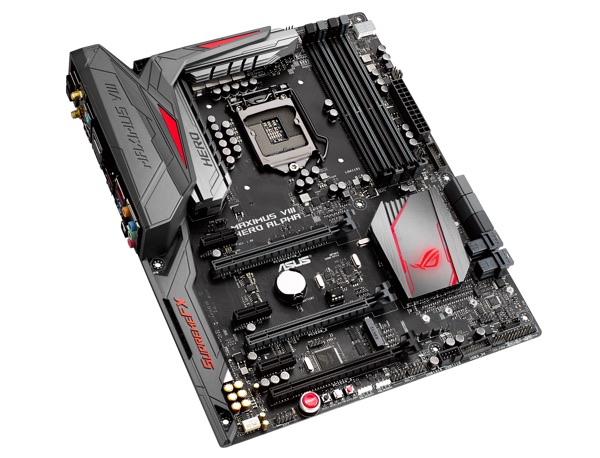Asus Republic of Gamers (ROG) expand the family of gaming motherboards targeted to users by introducing the new Maximus VIII Hero Alpha. A proposal for a very high-end which renews the MB Maximus line by improving the connectivity sector and presenting itself as the first ATX form card and chipset Z170 equipped with RGB connector that allows the integration of RGB LED strips 12v. Performance, watch out for tools dedicated to overclockers and a cure for purely aesthetic elements, enhanced by the aforementioned customizable lighting system, are the business card of the proposed new ASUS.
The motherboard supports Intel Core processors of the sixth generation, DDR4 and stands as an evolution of the previous Maximus VIII Hero. The connectivity park now includes a WiFi module 2x2 (2T2R) 802.11 ac MU-MIMO, USB 3.1 Type A and Type C, two NVM Express connectors (NVMe) and M.2 (speeds up to 32 GBbit / s); it lacks support for RAID configuarazioni up to three ways.
Users who like to personalize their homes with LED lighting systems will be able to exploit the system AURA RGB: on board there are two patented connectors AURA RGB-Strip to 4pin, are included in the supplied extension cable to connect the LED strips, while the management software allows you to manage the lighting effects also taking advantage of the RGB LED integrated into the card. There are six different color effects, comprendent among altrii fading and color strobe, and you can change colors to indicate the temperature of the CPU or sync with the rhythm of the music.
The motherboard supports Intel Core processors of the sixth generation, DDR4 and stands as an evolution of the previous Maximus VIII Hero. The connectivity park now includes a WiFi module 2x2 (2T2R) 802.11 ac MU-MIMO, USB 3.1 Type A and Type C, two NVM Express connectors (NVMe) and M.2 (speeds up to 32 GBbit / s); it lacks support for RAID configuarazioni up to three ways.
Users who like to personalize their homes with LED lighting systems will be able to exploit the system AURA RGB: on board there are two patented connectors AURA RGB-Strip to 4pin, are included in the supplied extension cable to connect the LED strips, while the management software allows you to manage the lighting effects also taking advantage of the RGB LED integrated into the card. There are six different color effects, comprendent among altrii fading and color strobe, and you can change colors to indicate the temperature of the CPU or sync with the rhythm of the music.
Not only aesthetic but also a lot of substance to allow power users to get the most from the components installed in the card. First the 5-Way Optimization technology allows to maximize performance without risk by monitoring and dynamic optimization of the essential aspects of the system (CPU, power supply, fans, audio, network).
To take advantage of the DDR4 RAM modules, reaching a higher level of 3800 MHz overclocking using all the memory slots, Asus has introduced the ASUS T-Topoplogy technology that helps reduce crosstalk and coupling noise and guarantees transfer of the aligned signals with measurable benefits in terms of compatibility and stability of the memories.
Intel's sixth-generation CPUs can be enhanced with technology Clock Pro that allows you to reach in overclocking base clock frequencies of 400 MHz. The technology works in tandem with ASUS ROG TPU to control voltages and overclocking. It does not lack attention to safety aspects and the noise of the cooling system that may benefit from assistance offered by the thermal sensors detecting the PWM / DC mode 4-pin / 3-pin in hardware and management software on the FanExpert 3 .
Rounding out the framework of the measures introduced to improve the audio sector (from the screen facilities, with professional components such as the DAC ESS ES9023P, the 2V RMS headphone output, the Nichicon capacitors, to arrive at the Sonic Studio II suite that lets you apply different audio effects ) and the experience of online gaming (the board integrates the Intel Gigabit Ethernet (I219-V), LANguard, components protected against voltage surges and electrostatic discharge).
The new ASUS Maximus VIII Hero Alpha is offered at a price of 315 Euros VAT included.
Following the detailed list of the technical characteristics:
Asus ROG Maximus VIII eroe Alpha
Processore / zoccolo del CPU Socket LGA1151 per processori Intel® Core i7 / i5 / i3 / Pentium® / Celeron® di Sesta Generazione
Chipset Intel Z170 espresso
Memoria
4 x DIMM, Fino a un massimo di 64 GB, DDR4 3800MHz (OC)
Supporto per Intel Extreme Memory Profile (XMP)
Slot di Espansione
2 x PCIe 3.0 x16 (x16, x8 / x8 Modalità supportate)
1 x PCIe 3.0 fessura (max Modalità x4 supportata)
3 x PCIe 3.0 x1 Slot
VGA
Processore Intel HD Graphics Integrato
DisplayPort 1.2 con risoluzione Massima di 4096 x 2304 a 60Hz
HDMI con risoluzione Massima di 4096 x 2160 a 24 Hz un
Intel InTru ™ 3D / Quick Sync Video / Clear Video HD / Insider ™
Multi-GPU bidirezionale / quad-GPU NVIDIA® SLI ™ e tre vie / quad-GPU AMD
Tecnologia CrossFireX ™
Archiviazione 6 x SATA 6.0 Gbit / s
2 x U.2
1 x M.2 Socket 3 con M chiave, Dispositivi di archiviazione di tipo 2242/2260/2280/22110 supportati (PCIe 3.0 e SATA)
Networking / LAN
Intel I219-V Gigabit LAN con ASUS LANguard e GameFirst IVBeta
Porte USB / Thunderbolt 2 x USB 3.1 (1 x tipo A e 1 x Type-C)
6 x USB 3.0 (2 sul Pannello posteriore, 4 mid-board)
6 x USB 2.0 (2 sul Pannello posteriore, 4 mid-board)
1 x Thunderbolt 3 (Type-C sul Pannello posteriore)
Audio
Audio ROG SupremeFX 2015 8 canali ad Alta Definizione
- SupremeFX Tecnologia
- Definizione DAC ESS ES9023P ad alta
- Amp cuffie 2VRMS (32-600 ohm)
- Jack-rilevamento, multi-streaming, sul pannello frontale mic jack-Retasking
- Porta ottica S / PDIF-out sul posteriore Pannello

Comments
Post a Comment